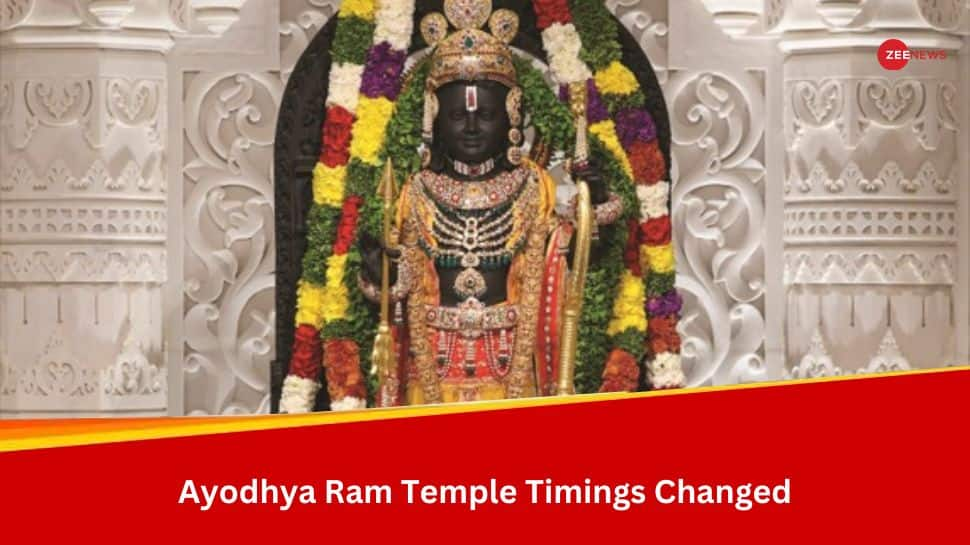AYODHYA: Shri Ram Janmabhoomi Teerth Kshetra Chief Priest Acharya Satyendra Das on Monday said that the public darshan of Sgri Ram Lalla will begin from Tuesday after the conclusion of the ‘Pran Pratishtha’ ceremony in Ayodhya. ”The darshan of Ram Lalla will begin from tomorrow,”Shri Ram Janmabhoomi Teerth Kshetra Chief Priest Acharya Satyendra Das said after the ‘Pran Pratishtha’ ceremony.
Revised Temple Timings
The timings for visiting the Ram Temple have been altered. Starting from 8:00 AM to 10:00 PM, devotees can now seek the blessings of Ram Lalla. Additionally, the temple will remain closed from 1:00 PM to 3:00 PM. According to the Shri Ram Janmabhoomi Teerth Trust, Ram Lalla will be offered fruit and milk every hour. The temple will open every day from 8:00 AM to 10:00 PM.
Colourful Attire For Ram Lalla
Ram Lalla will now don different coloured attire on specific days: white on Mondays, red on Tuesdays, green on Wednesdays, yellow on Thursdays, light yellow or cream on Fridays, blue on Saturdays, and pink on Sundays. The new attire has been crafted by skilled artisans associated with the Heritage and Handloom Revival Charitable Trust in Pune, involving 10 to 15 lakh artisans.
Temple Rituals And Schedule
After the ‘Pran Pratishtha’ ceremony concludes on January 23, the temple will remain closed during the day for cleaning, worship, and adornment of the sanctum sanctorum. Around 3:30 PM to 4:00 PM, the idols and ‘Shri Yantra’ will be awakened with mantras, followed by the ‘Mangala Aarti.’ Subsequently, there will be the consecration ceremony, adorned with rituals and offerings. The ‘Shringar Aarti’ will follow, concluding around 5:00 PM.
Morning darshan will begin at 8:00 AM, with a break from 1:00 PM to 3:00 PM. Evening darshan will continue from 3:00 PM until 10:00 PM, interrupted only by the evening ‘Sandhya Aarti’ at 7:00 PM.
PM Modi Leads Pran Pratishtha Rituals
The holy city of Ayodhya witnessed a moment of divine significance as the idol of Ram Lalla was unveiled at the Shri Ram Janmaboomi Temple, with Prime Minister Narendra Modi leading the sacred Pran Pratishtha ceremony on Monday. In the sanctum sanctorum of the grand temple, PM Modi conducted the rituals, creating an atmosphere infused with deep devotion. PM Modi performed the ‘aarti’ of the Ram Lalla idol at the Shri Ram Janmabhoomi Temple in Ayodhya. He also performed ‘parikrama’ of the deity and did ‘dandvat pranam’. He also took blessings from ‘sadhus’.
The childhood form of Lord Ram (the idol of Shri Ramlalla) has been placed in the main sanctum sanctorum on the ground floor of the temple. The ceremony was marked by Indian Air Force (IAF) choppers showering flower petals over the temple premises during the unveiling of the idol.
Ram Lalla Won’t Stay In A Tent Now: PM Modi
PM Modi congratulated people on the Pran Prathistha ceremony in Ayodhya temple and said Ram Lalla will not stay in a tent now. “Many congratulations to all the people of the country for this auspicious occasion,” PM Modi said. He said the grand temple has been constructed after centuries of sacrifice. “After centuries of unprecedented patience, countless sacrifices, renunciations and penances, our Prabhu Ram has come…” he said. “Ram Lalla will not stay in a tent now. He will stay in the grand temple…” the Prime Minister added.
Distinguished Dignitaries Witness Grand Ceremony
RSS Chief Mohan Bhagwat, Uttar Pradesh Governor Anandiben Patel, and Chief Minister Yogi Adityanath graced the ceremony, chanting ‘Jai Sri Ram’ along with devotees. Over 8,000 guests attended the ceremony, representing various spiritual and religious sects, including tribal communities. Prime Minister Modi addressed the distinguished gathering and interacted with shramjeevis associated with the temple’s construction.
Architectural Marvel Of Shri Ram Janmbhoomi Mandir
The Shri Ram Janmbhoomi Mandir, constructed in traditional Nagara style, stands magnificently with a length of 380 feet, width of 250 feet, and height of 161 feet. It boasts 392 pillars, 44 doors, and intricately sculpted depictions of Hindu deities.
The main entrance on the eastern side, accessed by ascending 32 stairs through Singh Dwar, leads to five Mandaps (Halls). Notable features include Nritya Mandap, Rang Mandap, Sabha Mandap, Prathana Mandap, and Kirtan Mandap. The historic Well (Sita koop) and the restored ancient Mandir of Bhagwan Shiv at Kuber Tila add to the cultural richness.
The Mandir’s foundation, crafted with a 14-meter-thick layer of roller-compacted concrete (RCC), gives it the appearance of artificial rock. The absence of iron and the use of traditional indigenous technology showcase the uniqueness of the construction. A 21-foot-high plinth of granite safeguards against ground moisture.
The Mandir complex boasts a sewage treatment plant, water treatment plant, water supply for fire safety, and an independent power station, seamlessly blending modern amenities with traditional architecture.

